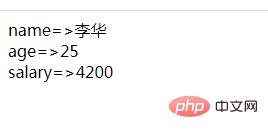
In the previous article "PHP array learning: How to traverse array elements? In "A Brief Analysis of 4 Methods", we introduced the 4 methods of traversing arrays in PHP. Let's continue to understand traversal and introduce to you how PHP objects are traversed. You can refer to it if necessary.
First of all, let’s understand what object traversal is: it mainly refers to traversing the externally visible attributes of the object (that is, the attributes declared by the access restrictor public).
So how to traverse the object? A common method of object traversal is to use the foreach statement. That's right, just use the foreach statement (isn't it very powerful, both arrays and objects can be traversed).
The foreach statement was indeed designed for traversing arrays at the beginning, but starting from PHP5, it adds new features-it can also traverse objects. The foreach statement has the same syntax format for traversing arrays and objects. There are two formats:
//语法格式1
foreach ($object as $value){
语句块;
}
//语法格式2
foreach ($object as $key => $value){
语句块;
} These two formats are actually very similar. The only difference is: Traversal in syntax format 1 $objec object, assign the "member attribute value" of the current object to $value in each loop; and in syntax format 2, traverse $ objec object, in each loop the "member attribute value" of the current object will be assigned to $value, and the "member attribute name" will be assigned to $key.
Let’s use code examples to see how the foreach statement traverses objects.
We define a class and instantiate the class into an object:
<?php
header("Content-type:text/html;charset=utf-8");
class Demo //定义一个类
{
public $name; //定义变量--成员属性
public $age; //定义变量--成员属性
public $salary; //定义变量--成员属性
public function __construct($name,$age,$salary) //定义函数--成员方法
{
$this->name = $name;
$this->age = $age;
$this->salary = $salary;
}
}
//实例化对象
$obj = new Demo('李华', 25, 4200);
?>Use the foreach statement to traverse the object
foreach ($obj as $value)
{
echo $value.'<br>';
}Let’s take a look at the output:
Is not it simple. After instantiating the object, directly use the foreach ($obj as $value) statement to obtain all visible properties in the $obj object.
Only the "member attribute value" is obtained above. Sometimes we need to obtain the "member attribute name" and "member attribute value" values together, so we can use the second format of the foreach statement:
foreach ($obj as $key=>$value)
{
echo $key.'=>'.$value.'<br>';
}Let’s take a look at the output:

That’s all. If you want to know anything else, you can click this. → →php video tutorial
Recommended: 《PHP interview questions summary (collection)》
The above is the detailed content of PHP Loop Learning 6: How to Traverse Objects. For more information, please follow other related articles on the PHP Chinese website!




